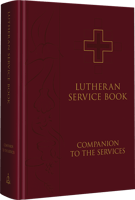The Daily Office has given voice to the daily prayer of the faithful in “many and various ways” over the centuries (LSB, p. 238; Hebrews 1:1). The name “daily” ties these services to the Christian’s temporal existence, defined as it is by our daily rising with the new sun—a reminder of the Lord’s resurrection—and daily return to bed in the confidence that Christ, the Light of the world, would bring safety and repose during the night hours. Lacking the mandate of the Divine Service, these services fall more on the spectrum of personal devotion, spanning the gamut from the instruction in the Didache to pray the Lord’s Prayer three times a day (likely a reference to personal prayer) to the highly structured services of the monastery (community prayer). Concurrently, the character of the service is more along the lines of thanksgiving, praise, and intercession rather than on instruction.
Background
Inspired by Psalm 119:164, “seven times a day I praise You,” plus verse 62, “at midnight I rise to praise You,” the day was divided into eight periods of fixed prayer, observed historically in cathedrals and monasteries. The services of prayer said at each of these canonical hours are known collectively as the Daily Office. It was an outgrowth of Jewish and early Christian times of prayer (Acts 3:1), used both congregationally (cathedral hours) and especially in the monasteries. From the sixth century, it included eight services each day devoted to praying the complete Psalter (weekly) with other readings, hymns, and canticles. At one time, it was a discipline required of all clergy. Simplified in most places during the Reformation (similarly in later Roman revisions), the Daily Office persisted especially in Latin schools. It is often reduced to morning (Matins) and afternoon/evening (Vespers) offices, and occasionally a single midday office (reminiscent of cathedral practice).
Matins (also sometimes called “Vigils”) comes from the French matines and the Latin matutinus (“belonging to the early morning”). The first service of the Daily Office, Matins is prayed in the early morning. Formerly, the service of Vigils was kept in the middle of the night in the monasteries, featuring multiple readings interspersed with psalms and responsories. Even before the Reformation, elements of Matins (Vigils) were often assumed into Lauds as a single morning service bearing either name. In LSB, Matins and Morning Prayer reflect this tradition.
Historically, the order of the Daily Office was in some respects chaotic. Nonetheless, an essential core of primary elements formed the basis of later reform. These elements can be summarized as follows:
- Opening Versicles
- Psalmody
- Office Hymn
- Scripture Readings
- Biblical Canticle
- Prayer
There is a clear and simple rhythm to this outline. The Word of God alternates with the worshiper’s response in prayer and praise.
Opening Versicles
The opening versicle of Matins, “O Lord, open my lips, and my mouth will declare Your praise” (Psalm 51:15), confesses an essential truth: that our speaking to and about God is vain babbling unless He is the one who opens our mouth and fills it with fitting words of prayer, praise, and thanksgiving for His wondrous deeds. The Church has understood this truth instinctively over the centuries as she has wrapped any talk about the gifts of God with His very words, often taking them directly from the Scriptures, so that we might rightly extol His mercy and goodness.
Psalmody
In the earliest development of the cathedral office, the entirety of the Psalter was not prayed on a regular basis; rather, certain psalms appropriate to the time of day became associated with morning and evening prayer. . . . By the early sixth century, however, Psalm 95 emerged as the fixed psalm at the beginning of the day in the Daily Office in the Roman rite. As with many other parts of the service, the Venite derives its name from the opening word of the psalm in Latin: venite, “O come.” Additional psalms may be selected according to the season or from the “Table of Psalms for Daily Prayer” (LSB, p. 304).
Office Hymn
Especially appropriate for Matins are hymns with themes associated with the beginning of the day (e.g., LSB 868–876). Many Latin hymns originally had their origin as office hymns (e.g., LSB 385, “From East to West” and LSB 454, “Sing, My Tongue, the Glorious Battle”) and are fitting for Matins.
Readings
While the singing of the psalms formed the essential core of the Daily Office, the reading of Holy Scripture also held an important place. . . . While no provision was made (at least at first) for a systematic reading of the entire Bible, the monastic offices, in particular, did provide for a generous coverage. This was especially true in Matins, where in the monastic tradition there could be as many as twelve readings on Sundays, though considerably fewer on other days of the week. The readings, together with their corresponding responsories, formed an essential core of the office. . . . Today, Scripture passages may be selected from various lectionaries, reading plans, or from the LSB Daily Lectionary (LSB, pp. 299–304), which uses the same readings as those included in Treasury of Daily Prayer.
After the readings, Matins allows for a sermon or catechetical instruction. . . . Another option in less formal settings, or when praying the office alone, is the reading of a prepared devotion from any number of published resources.
Canticle: Te Deum or Benedictus
The Te Deum is a trinitarian and Christological hymn that unites proclamation with prayer and praise. The legend describing the origins of the Te Deum is a favorite. Already in the eighth century, the story was told of how Ambrose and Augustine spontaneously composed this venerable hymn of praise when Ambrose, the renowned bishop of Milan, baptized Augustine in 387. Luther was not convinced of the veracity of this account, though he saw no harm in believing it. More recent scholarship has debunked the myth, and scholars are only able to say with certainty that the canticle was written in Latin some time in the early fifth century, perhaps having been compiled by Bishop Nicetas.
The use of Zechariah’s song of thanksgiving following the circumcision and naming of his son, John, (Luke 1:68–79) is of long-standing usage in the Daily Office. The allusion to light (“when the day shall dawn upon us”) may be one of the reasons for its use as a morning canticle.
In addition to the much-loved setting of the Te Deum in Matins, LSB provides three alternate settings that can be substituted on occasion: LSB 939, “You Are God; We Praise You”; LSB 940, “Holy God, We Praise Thy Name”; and LSB 941, “We Praise You and Acknowledge You, O God.” For the Benedictus, in addition to the setting in Matins, there is one hymn paraphrase at LSB 936, “Sing Praise to the God of Israel.”
Prayer
Given that the various services of the Daily Office are prayer offices, this final section on prayer brings each to a fitting conclusion. In the early cathedral office, the people found the prayers to be one of the few places where they could actively participate as they cried out their “Kyrie eleison” to a series of prayer bids. . . . One option in the Daily Office is that of replacing the entire Prayer section with the Litany (LSB, pp. 288–89), Responsive Prayer (LSB, pp. 282–87), or the Bidding Prayer (LSB Altar Book, pp. 406–409). . . . For example, during Lent, the Litany would make a fitting substitution.
Gathered for Prayer
The services in LSB provide great flexibility to serve in our own day in a multitude of settings. Wherever Christians gather daily for prayer, these services can be used as presented in the book, making slight adaptations, such as how many psalms, readings, and hymns to include, according to the time and musical forces that are available. If a congregation prays Matins . . . on a Sunday morning when the Sacrament is not celebrated, [this] service will normally be used in all [its] fullness, including multiple psalms, several readings, hymns, and a fuller selection of prayers. On the other end of the spectrum, individuals and families can find great benefit in praying the offices, simplifying the rites as needed to fit the abilities and needs of those using the rites.
Blog post excerpted from Lutheran Service Book: Companion to the Services, pages xxxv, xlii, 663, 666–67, 690–91, 697, 699, 701, 703, 708, 712, 716, © 2022 Concordia Publishing House. All rights reserved.
Scripture: ESV®.
 Read the rich and complex history of Lutheran Service Book through comprehensive explanations in Lutheran Service Book: Companion to the Services.
Read the rich and complex history of Lutheran Service Book through comprehensive explanations in Lutheran Service Book: Companion to the Services.














.jpg?width=50&height=50&name=IMG_20220621_160541_456%20(1).jpg)
